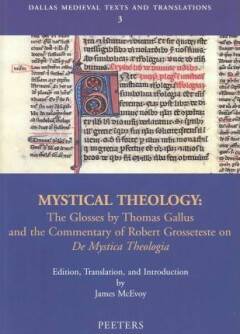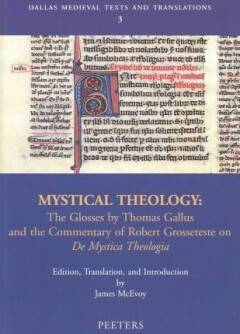
- Afhalen na 1 uur in een winkel met voorraad
- Gratis thuislevering in België vanaf € 30
- Ruim aanbod met 7 miljoen producten
- Afhalen na 1 uur in een winkel met voorraad
- Gratis thuislevering in België vanaf € 30
- Ruim aanbod met 7 miljoen producten
Zoeken
Mystical Theology
The Glosses by Thomas Gallus and the Commentary of Robert Grosseteste on de Mystica Theologia
J McEvoy
€ 74,95
+ 149 punten
Omschrijving
The treatise by the Pseudo-Dionysius De Mystica Theologia was translated into Latin in the ninth century, but it had to await the first decades of the thirteenth to receive interpretation and commentary. Thomas Gallus, a member of the Victorine School at Paris, glossed the Latin version of Iohannes Sarracenus in 1233. This new, critical edition and translation are based upon all five manuscripts, two of which are recent discoveries. The commentary by Bishop Grosseteste was made at Lincoln around 1242. It was based upon his new version of the Greek text. Both are published here with a translation. These earliest Latin commentators ventured a full-scale reappropriation of the contents of The Mystical Theology. They explored the trans-conceptual ecstasy of the individual soul that passes through purification and illumination to union with God by means of an exceptional grace of divine love. Between them they provided the context which not only the later mystical theology of monastery and university but also the actual spiritual experience of countless souls was formed.
Specificaties
Betrokkenen
- Auteur(s):
- Uitgeverij:
Inhoud
- Aantal bladzijden:
- 139
- Taal:
- Engels
- Reeks:
- Reeksnummer:
- nr. 3
Eigenschappen
- Productcode (EAN):
- 9789042913103
- Verschijningsdatum:
- 13/10/2003
- Uitvoering:
- Paperback
- Formaat:
- Trade paperback (VS)
- Afmetingen:
- 171 mm x 239 mm
- Gewicht:
- 435 g

Alleen bij Standaard Boekhandel
+ 149 punten op je klantenkaart van Standaard Boekhandel
Beoordelingen
We publiceren alleen reviews die voldoen aan de voorwaarden voor reviews. Bekijk onze voorwaarden voor reviews.








